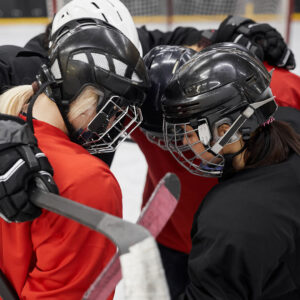For many Canadians, the hockey arena is a second home. They spend countless hours there as athletes, coaches, and fans alike. Since the pandemic, it feels like they’ve been evicted from that home due to COVID-19 lockdowns suspending play.
With team activities currently prohibited in many provinces, communities are fighting to be heard as they bring attention to the need for recreation facilities to be reopened to youths. They are looking for help and answers, seeing no immediate relief with return-to-play measures absent amongst provincial reopening plans. Still, a glimmer of hope remains for easing restrictions as time is running out on the season.
Seeing it from both sides of the argument, safety protocols are in place to protect the community and control the spread of COVID-19. The number of cases per province impacts the level of restrictions, putting some provinces back in lockdown situations since the end of 2020. But concerns are mounting over the devastating effects these limitations have on our youth’s physical and mental health. Physical activity and social interaction are extremely important for development. With everything coming to a stop, they have lost a key coping mechanism for anxiety and stress.
Over the past few weeks, this important issue has made headlines in Alberta, Manitoba and Saskatchewan.
On February 2, Hockey Alberta confirmed the decision to cancel the remainder of regular league play seeing March 1 as the earliest athletes would be able to return to the ice, according to reopening plans, making it difficult to continue. This comes a week after protests were held in many Alberta communities in response to the province’s announcement that the ban on team sports would continue for a while longer. They wanted to give the athletes a voice to speak out about how they are affected, knowing a decision was pending from Hockey Alberta.
Hockey Winnipeg also recently cancelled the remainder of their minor hockey season. Current restrictions, timelines for return (or lack of a timeline) and ice availability didn’t make a season feasible.
In Saskatchewan, parents petitioned to let children play games, putting pressure on the government to take more action. Provincial protocols currently permit conditioning and skills training in groups of eight or less under the age of 18.
Where some provinces have been able to continue, albeit far from a traditional season, others are trying to salvage any opportunity to provide ice time for teams. Those provinces with lockdowns permit social distanced skating in small numbers but prohibit any hockey-related activity for the general public. Underlying the major concern of mental health is how these athletes are falling behind in their skill development and what that could mean for the future.
Navigating how to safely operate according to provincial protocols has been a continuous struggle. Many leagues and hockey associations have worked hard to develop guidelines for safe return to play and were willing to work with governing bodies and provincial regulations to keep participants and communities safe. iPlayHockey has created a set of recommendations for resuming recreational hockey (click here to view). Strict and clear policies are required, as well as a stringent commitment to follow them.
Modified plans can provide youth with an outlet essential for growth and development. A survey released by Hockey Calgary showed that the majority of parents want their kids to play the sport in some capacity. The decision to cancel the hockey season does not have to mean the end of hockey activity. Local programming or developmental seasons can provide some relief. This step could consist of on-ice skill development through non-contact drills and keeping practice sizes small.
Part of Hockey Alberta’s statement regarding their cancellation included the intention to “continue working with government and health officials to develop a relaunch plan that allows for hockey activities and keeps our youth active for their physical and mental well-being.”
Again, this comes down to provincial restrictions for gatherings and the lack of timelines for when these will be lifted. The organized protests wanted government to be aware that the absence of an action plan for return to play may jeopardize what options are available when that time comes.
With reopening plans, it could be too late once decisions are made. As arena doors stay closed, facilities struggle with operating costs. The spiral effect of keeping teams off the ice has an economic impact as well.
In Orangeville, Ontario, a proposal was made to the Town Council by the Orangeville Minor Hockey Association (OMHA), Skate Canada, and Orangeville Tigers Girls Hockey for reduced ice costs to keep programming going. Without assistance, the organizations would be unable to afford the increased amount of ice time in order to account for the limited group sizes permitted during a rental period. While there is a significant cost to Council to reduce the fees, projected to be approximately $120,000, they understand the value hockey brings to the community and the importance of these programs for keeping youth active.
Without decisions, these rinks will be forced to close leaving options limited.


